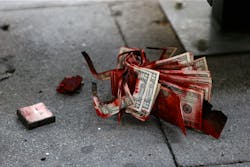The FBI has just released its 2011 research data on bank robberies and the results are enlightening (see SIW article on 2011 data | see FBI source data). Here’s what we know: Bank robbers are morning people who prefer to work between 9-11 a.m. They’re also Friday people, with more bank robberies reported on Fridays than any other single day of the week. They aren’t adverse to small towns. Metropolitan area bank robberies are the most common, but small town robberies aren’t far behind and are significantly more popular than suburban locations. Men were more likely than women to commit these crimes, at a ratio of more than 12 to 1. Finally, there were a total of 5,014 bank robberies, 60 bank burglaries and 12 bank larcenies, for a total of 5,086 bank crimes tracked by the FBI.
What’s fascinating is that of the $38,343,501.96 stolen in these 5,000-plus incidents, only $8,070,886.97 was recovered – just 21 percent. For all of the cameras and dye packs and alarms, there was still $30 million in loot taken last year from banks that was not recovered. After recoveries are made, $30,272,614.99 is lost between 5,086 incidents for an average loss (after recoveries) per incident of $5,952.
Of course, that doesn’t count the human victimization costs. There are costs to the banking institutions of lost productivity, therapy for those persons involved in robberies (especially violent robberies and hostage taking situations), medical costs from the injuries and deaths (88 injuries and 13 deaths were reported from bank robberies in 2011). If we added these costs, these incident loss numbers would be even higher, and there’s a growing school of thought in crime research which says we should track victimization costs.
Let’s look at the technology and solutions used in these 2011 bank crime incidents. Of the 5,086 incidents, only 5.4% saw the use of functioning electronic tracking devices. Only 4.6% of the victim institutions had guards. Some 24% of the institutions had tear gas/dye packs available to use against the perpetrators, but only 38% of those that had such gas and dye packs were able to use it. Bait money was taken in 31.5% of these bank crimes.
Video surveillance camera systems typically were activated in over 97% of the incidents, 89.5% of the incidents saw the alarm systems activated. Despite the activation of those systems, a small percentage of both the cameras (1.5%) and alarm systems (1.3%) were not functioning. What’s more interesting than the percent of non-working security technology devices is the lack of technology altogether. About 1% of the victim institutions didn’t even have cameras and the same percentage didn’t even have an alarm system.
We talk about return on investment in our industry a lot, because security is often seen as a cost-center for a business with little ability to prove its return on value. With an average loss after recoveries of close to $6,000, how much ROI do you need to invest in security technologies? As a security director for any type of institution, are you tracking your own incidents and also tracking which solution investments you’ve made that actually helped resolve the incidents? Can you tell your corporate team in what percentage of your incidents guards were useful in stopping the crime? Can you say in what percentage of your incidents you were able to obtain a useful image of the perpetrator from your CCTV system? Tracking the crimes and losses is good – but tracking our effectiveness and the effectiveness of our security investments is even better.
About the Author

Geoff Kohl
Editorial Director/Editor-in-Chief/Associate Publisher
Geoff Kohl is the Marketing Director for the Security Industry Association (SIA). He is the former Editor-in-Chief of SecurityInfoWatch.com
